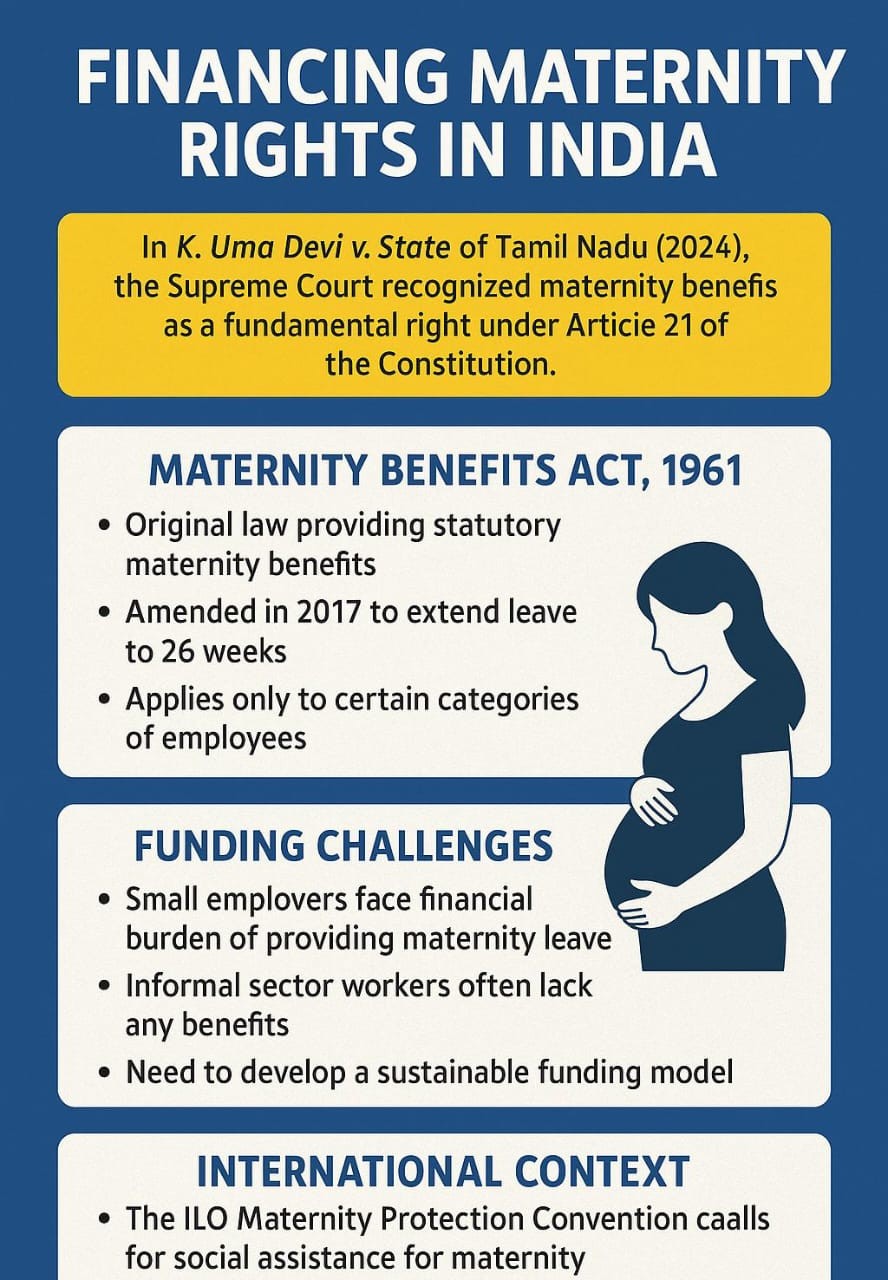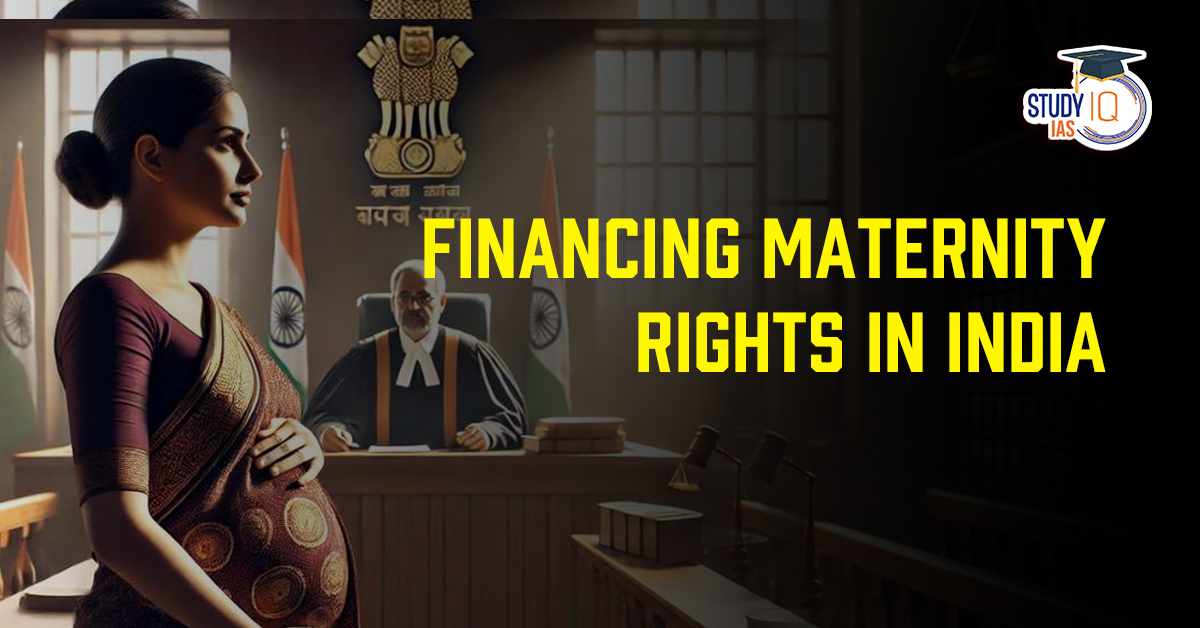Table of Contents
On May 23, 2024, the Supreme Court of India delivered a landmark verdict in K. Uma Devi v. State of Tamil Nadu, affirming that maternity rights are an integral part of the fundamental rights enshrined in Article 21 of the Constitution. This decision is a crucial milestone in acknowledging reproductive and maternal health as essential elements of the right to life and personal liberty, and it indicates progress in the legal and constitutional safeguarding of women in the workforce.
Financing Maternity Rights in India

Background of the Case: K. Uma Devi v. State of Tamil Nadu
- K. Uma Devi, a temporary employee at a government institution in Tamil Nadu, petitioned the Supreme Court after being refused maternity benefits because of the irregularity of her employment status.
- Her appeal centred on rejecting mandatory maternity benefits stipulated by the Maternity Benefit Act of 1961 (MB Act) and the wider ramifications for women’s fundamental rights.
- The petitioner argued that the refusal infringed upon her right to equality (Article 14), right to health and reproductive autonomy (Article 21), and freedom to pursue any profession (Article 19(1)(g)).
- The Supreme Court, in its ruling, broadened the scope of Article 21 to encompass maternity benefits, holding that reproductive rights are not only legal privileges but fundamental to the dignity and autonomy of working women.
- The Court construed the MB Act under international norms and constitutional principles, so strengthening the legal foundation for maternal health and job security.
Constitutional Framework for Maternity Rights
- The Supreme Court stated that maternity leave is essential to maternity benefits, and reproductive rights are now acknowledged as components of international human rights legislation, including the rights to health, privacy, equality, non-discrimination, and dignity.
- The Supreme Court bench, emphasising Article 21 of the Constitution, stated that Judicial interpretation has established that life under Article 21 encompasses life in its entirety; it includes all elements that render life more meaningful and worthy of human existence.
- The right to life encompasses the essential attributes of human civilisation, hence making this fundamental right a storehouse of many human rights.
- The right to life encompasses the right to health.
- The right to live with human dignity and the right to privacy are now recognised components of Article 21.
- Article 21 of the Indian Constitution ensures the right to life and personal liberty.
- Over the decades, this Article has developed to encompass numerous socio-economic rights, including the rights to health, dignity, and reproductive autonomy.
- The Supreme Court’s view in this ruling adheres to precedents like Suchita Srivastava v. Chandigarh Administration (2009), which acknowledged reproductive rights as encompassed within Article 21.
- Article 42 of the Directive Principles of State Policy requires the State to ensure equitable and humane working conditions and to provide maternity relief.
- The Directive Principles, while not legally enforceable, provide essential guidance for the interpretation of fundamental rights, especially in matters of social justice.
Maternity Benefit Act 1961: Normative Framework
- The Maternity Benefit Act of 1961 is the foundation of India’s maternity rights framework.
- The Maternity Benefit Act, 1961, is a significant legislative measure in India designed to safeguard the rights of employed women throughout pregnancy, childbirth, and the postpartum period.
- The Act was enacted to guarantee that women in India need not choose between their professional pursuits and motherhood.
- The law aims to establish a safer and more supportive workplace for women by offering paid maternity leave and related benefits.
- The legislation has experienced multiple revisions, the most significant being the Maternity Benefit (Amendment) Act, 2017, which substantially extended the duration of maternity leave and incorporated additional provisions for the advantage of working mothers.
- The Act stipulates 26 weeks of paid maternity leave for women in enterprises with ten or more employees.
- It additionally provides advantages to adoptive and commissioning mothers and implements flexible work arrangements.
- Notwithstanding its progressive conditions, the Act fails to uniformly encompass women in the unorganised and informal sectors, who represent the majority of India’s female workforce.
- This disparity has resulted in structural inequalities in the implementation of maternity benefits.
- The Court underscored the necessity of extending maternity protection to all employed women, irrespective of their employment type.
International Legal Framework and Judicial References
- The court’s decision cited international agreements like the Universal Declaration of Human Rights (UDHR), the Convention on the Elimination of All Forms of Discrimination Against Women (CEDAW), and the International Labour Organisation’s (ILO) Maternity Protection Convention C183 (2000).
- CEDAW, adopted by India in 1993, mandates the State to eradicate discrimination against women in the workforce, including provisions for maternity protection.
- The ILO’s C183 Convention advocates for a minimum of 14 weeks of paid maternity leave, access to healthcare, and the entitlement to resume the same position following maternity leave.
- India’s MB Act exceeds these benchmarks with its 26-week leave program, rendering it one of the most progressive globally.
Challenges in Implementation: Financing Maternity Rights
- The Supreme Court’s acknowledgement of maternity benefits as a fundamental right prompts inquiries regarding its execution, especially in the informal sector.
- Employers, particularly small and medium enterprises (SMEs), may find it challenging to absorb the expenses associated with prolonged maternity leave.
- The ILO standards indicate that maternity benefits need not be exclusively covered by employers but should be provided through social insurance systems or public resources.
- India’s existing framework is predominantly based on employer liability, potentially resulting in discriminatory recruitment practices towards women.
- The Bombay Maternity Benefit Act of 1929 established a non-contributory, employer-funded framework.
- Considering the magnitude and intricacy of India’s current workforce, a universal maternity financing scheme, such as a National Maternity Fund, could provide more fair access.
Global Relevance and Comparative Perspectives
- The ILO’s 2022 Report on ‘Care at Work’ indicated that 123 countries offer fully paid maternity leave, encompassing 90% of mothers worldwide.
- India ranks among the 42 countries that provide maternity leave of 18 weeks.
- Nevertheless, only a limited number of nations finance maternity benefits exclusively through employers.
- Countries such as Norway and Sweden employ tax-based and social insurance frameworks to deliver universal maternity coverage. These instances illustrate the viability and fairness of shared-cost maternity funding, facilitating greater involvement of women in the labour market.
Policy Recommendations and the Way Forward
- To put into effect the Supreme Court’s progressive judgement, the subsequent measures are advised:
- Creation of a National Maternity Fund: This can emulate the Employees’ State Insurance Scheme (ESIS) model, funded by payments from businesses, employees, and the government.
- Expansion of Coverage: Encompass all employment categories, especially the informal sector, within the scope of the MB Act.
- Encourage SMEs: Offer tax incentives and subsidies to smaller firms for adherence to maternity benefit regulations.
- Awareness Campaigns: Educate female workers and employers about their rights and responsibilities.
- Stringent Monitoring Systems: State labour departments must guarantee adherence through inspections and complaint resolution mechanisms.
- The Supreme Court’s ruling in Uma Devi v. State of Tamil Nadu is a pivotal point in Indian constitutional law, affirming the objective of a gender-equal workforce.
- It asserts that maternity benefits are not simply legal privileges but fundamental rights derived from the Constitution’s dedication to dignity, equality, and social justice.
- Efficient funding and comprehensive execution are essential for actualising these rights for all working women in India.
- By utilising worldwide best practices and constitutional requirements, India can create a sustainable and equitable maternity benefits system that respects the dignity of all women, irrespective of their job situation.


 Reserved vs General Quota: Supreme Court...
Reserved vs General Quota: Supreme Court...
 Supreme Court’s Interim Order on the W...
Supreme Court’s Interim Order on the W...



















